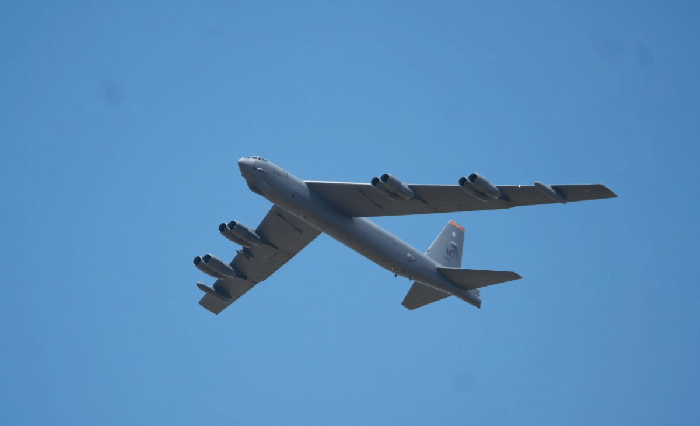The United States continues to remain a pioneer in defense manufacturing with an array of fighter jets, stealth bombers, attack submarines, aircraft carriers, and strategic, nuclear-capable bombers.
However, it’s not just the state-of-the-art features of stealth fighters like the F-35s and F-22s along with other advanced weapons systems that make the Pentagon stand tall amidst other nations, but their longevity to sustain through decades of technological advancements — An example led by none other than American’s 65-year-old veteran bomber aircraft, the Boeing B-52 Stratofortress.
Designed and built by US aerospace juggernaut Boeing in 1952, the B-52 “Stratofortress” better known as “BUFF” (Big Ugly Fat Fella) is a long-range, subsonic, jet-powered strategic bomber operated by the US Air Force since its official induction in 1955.
It is one of the oldest aircraft in service with the US Air Force, which was built to carry nuclear weapons for Cold War-era deterrence missions by replacing the largest mass-produced piston-engined aircraft called the Convair B-36 Peacemaker.
Boeing emphasizes the importance of the United States’ multirole historic bomber which has had a combat history in the Vietnam War, the Persian Gulf War, the Bosnian and Kosovo conflict, the Afghanistan War and the air campaign against Islamic State in Iraq and the Levant (ISIL).
“The Boeing B-52 primarily provides the United States with immediate nuclear and conventional global strike capability. The B-52 is the most combat-capable bomber in the U.S. inventory. Due to its high mission-capable rate, large payload, long-range, persistence and ability to employ both nuclear and conventional precision standoff weapons, the B-52 continues to be a critical contributor to the U.S. National Security Strategy,” according to a statement by Boeing.

In fact, such has been the success of these large bombers that they continue to competitively operate two decades into the 21st century and if the Air Force has its way, the aircraft could be equipped with newer engines to keep them operational through the 2050s, making them the first jets to be in service for 100 years.
What Makes The B-52 Bombers Unique?
So, why are the B-52 Bombers so successful despite being in an age filled with technological breakthroughs? There is not one single answer to it due to the plane’s list of traits similar to its tall stature.
Boasting a wingspan of 185 feet (56 meters) and a length of 160 feet 10.9 inches (49 meters), the B-52 is the largest aircraft of its role currently in service.
Powered by eight jet engines mounted under the wings in four twin pods, the massive plane can attain a maximum speed of Mach 0.9 (595 miles per hour, or 960 km/hr) at 55,000 feet (17,000 meters), and is also capable of flying at Mach 0.5 (375 miles per hour, or 600 km/hr) while only being a few hundred feet above the ground.
Moreover, the aircraft was conceived due to the need for a long-range strike aircraft in the aftermath of the bombing campaign against Japan. The need of the hour still remains the same with the Pentagon remaining focused on China’s advances in the Indo-Pacific, which calls for a bomber that can travel long distances to provide offensive as well as defensive support.
“The design of the B-52 gradually evolved during its early design phase into a swept-wing aircraft with eight jet engines that could fly many thousands of miles without refueling. Its range today is stated at 8,800 miles when cruising at 525 miles per hour with a 35-ton bomb load, but it can be refueled in the air to fly much farther,” said Loren Thompson, a senior contributor at Forbes.
Most importantly, the B-52s have a massive weapons payload of more than 70,000lb, enabling them to carry the most diverse range of weapons than any other combat aircraft.
While the nuclear weapons capacity includes 12 AGM-129 advanced cruise missiles (ACMS), 20 AGM-86A air-launched cruise missiles (ALCM) and eight bombs, the conventional weapons capacity is absolutely something else.
It includes eight AGM-84 Harpoon missiles, four AGM-142 Raptor missiles, 51,500lb bombs, 301,000lb bombs, 20 AGM-86C conventional air-launched cruise missiles (CALCM), 12 joint stand-off weapons (JSOW), 12 joint direct-attack munitions (JDAM) and 16 wind-corrected munitions dispenser (WCMD).
The aircraft also stands as the first one to be equipped with the joint air-to-surface standoff missile (JASSM), which was cleared for operational use in October 2003.
“Equipped with cruise missiles and other standoff munitions, it can attack targets anywhere in the world quickly from bases in the U.S. That’s what makes long-range bombers different from any other combat system in the joint force,” said Thompson.
Moreover, the large airframe of the aircraft is also modifiable with sophisticated weapons systems that cater to different purposes. According to a report by Britannica,
“The huge airframe of the B-52 earned it the nickname “Big Ugly Fat Fellow” (BUFF), but it also allowed the plane to be retrofitted with highly sophisticated navigational, weapons-control, and electronic countermeasures systems. Over the years, the bomber has frequently served as a “mother ship” for air-launching experimental aircraft, such as the X-15 and the X-43.”
While there is a need for aircraft in the current generation to be adaptable to changing combat scenarios especially in an era where countries like Russia, China, France, Germany and Britain continue to give the US a run for its money in the field of defense innovation, B-52’s simplicity and flexibility continue to make it a dominant force among the likes of modern bombers which are equipped with stealth technology.
According to Michael Blades, vice president of aerospace, defense and security at Frost & Sullivan – “The B-52 has been able to last as long as it has for a few reasons. The main issue is its simplicity. Its control surfaces are moved by cables, pulleys, and hydraulics. It is a much simpler system than newer fly-by-wire technologies that are more complex and more difficult, and expensive, to repair.”
Another factor that has led to the Stratofortess’s longevity is its flexibility. It was designed to deliver nuclear weapons over long distances but is just as effective at launching ALCMs (American subsonic air-launched cruise missiles), dropping conventional bombs for carpet bombing, or delivering precision-guided munitions for more surgical strikes.
All in all, the simpler design has been easier to repair, easier to upgrade, and easier to modify than most modern aircraft.
While B-52 is the US’ go-to strategic bomber, the nation also operates the B-1 Lancer and B-2 Spirit strategic bombers, having the largest inventory of aircraft capable of being deployed to carry out bombing missions around the world.
The B-52 has been essential in projecting American might in the South China Sea and has served in virtually every conflict the U.S. has been involved in, and by the looks of it, if the Air Force is successful in equipping it with newer engines, only sky’s the limit for its future term of service.




